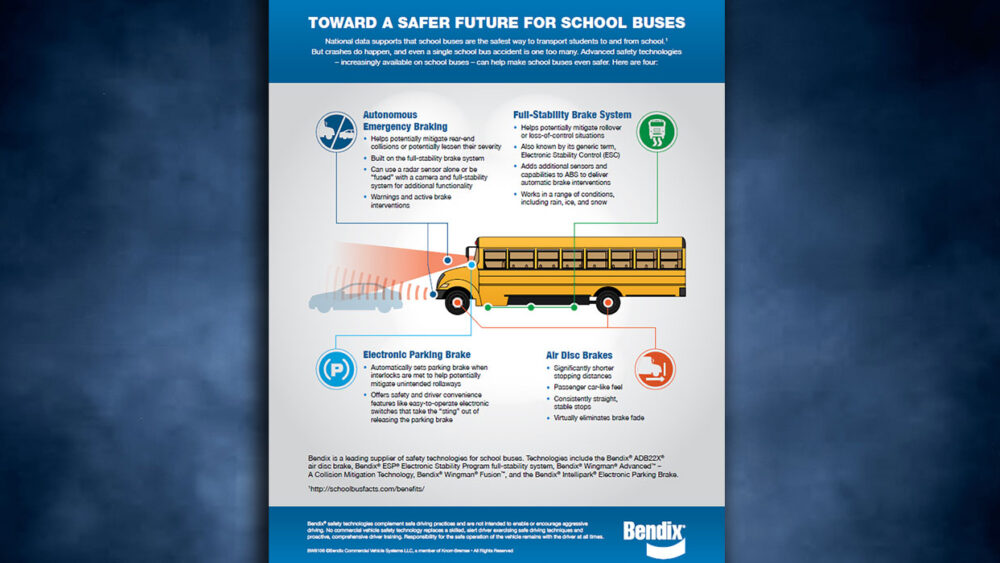Bendix school bus safety spec’ing tips


The classic yellow school bus is a symbol of safety in America, and for good reason: It is well documented as the safest form of student transportation. Bendix Commercial Vehicle Systems LLC offered a glimpse at technologies and training developed to make school bus transportation across North America even safer.
Click Here to Read More
ADAS advantage
The National Association for Pupil Transportation (NAPT) strategy in its zero-fatality campaign includes encouraging the utilization of the latest vehicle safety equipment and technology, such as electronic stability control, forward collision warning, collision mitigation, air disc brakes, and electronic parking brakes.
The Bendix ESP Electronic Stability Program full-stability system has been standard equipment on air-braked buses at both Blue Bird and IC Bus since 2018. This despite full-stability technology–while already mandatory on most motorcoaches and commercial vehicles–not being required for school buses.
BendixWingman Advanced uses a single radar sensor mounted to the front of the vehicle to deliver active cruise control with braking features, providing both warnings and active interventions to help drivers potentially mitigate or potentially lessen the severity of rear-end collisions.
Bendix WingmanFusion integrates a forward-facing camera with the radar and the vehicle’s brake system, creating a comprehensive driver assistance system. With a suite of sensors working together, and not just in parallel, Fusion uses multisystem integration to create a detailed and accurate data picture, setting it apart from radar-only systems.
Bendix collision mitigation technologies are on the road helping protect school bus occupants: IC Bus became the first North American school bus manufacturer to offer collision mitigation as a standard feature in 2018, spec’ing Wingman Advanced on its CE Series and RE Series, and offering the Wingman Fusion system as an option on the CE Series.
Air disc brake differences
As with driver-assistance technologies, more districts are equipping vehicles with air disc brakes, which provide shorter stopping distances than drum brakes and perform with little to no brake fade. During stop-and-go usage–like a school bus route–or downhill applications, drum brakes can heat up and experience decreased performance. The design of air disc brakes all but eliminates fade. Air disc brakes also provide shorter, smoother, and more stable stops than drum brakes.
Air disc brakes at the wheel-ends offer another advantage as well: They help optimize performance of the higher-level safety systems that are also becoming more common in school bus fleets.
All of North America’s major school bus manufacturers–including Blue Bird Corporation, Navistar’s IC Bus, and Thomas Built Buses–offer the industry-leading ADB22X as a factory-installed option.
Park smart
Another technology to enhance safety and driver convenience is found in the Bendix Intellipark Electronic Parking Brake. The system helps to potentially mitigate or lessen the severity of rollaway and runaway crashes by automatically setting the brakes when the system interlocks are met, indicating the driver has forgotten to do so.
The system monitors inputs in critical areas–for example, status of the foot brake, the accelerator pedal, and wheel speed may be monitored–to help determine when the driver inadvertently forgot to set the parking brakes and the vehicle should be parked. And since Intellipark is electronic, it is also positioned for integration with Wingman Fusion, enabling the use of the parking brakes to further enhance driver assistance functions.
Driver and Technician training
As school bus technologies rapidly evolve and advance, up-to-date proper training on their use and maintenance has become even more important to keeping drivers and their young charges safe. Bendix offers a combination of hands-on experiences, continuous education, and ongoing communications to help school bus fleets and drivers understand new technologies, learn what these technologies do in traffic situations to help, and, overall, keep their skills sharp.





